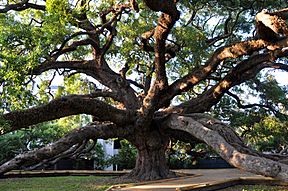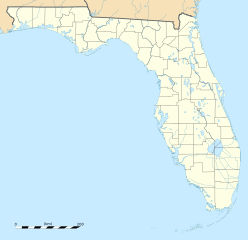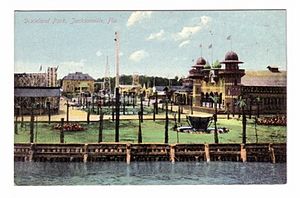Treaty Oak (Jacksonville) facts for kids
Quick facts for kids Treaty Oak |
|
|---|---|

Jacksonville's Treaty Oak
|
|
| Species | Southern live oak (Quercus virginiana) |
| Coordinates | 30°19′01″N 81°39′29″W / 30.3170°N 81.6581°W |
The Treaty Oak is a very old and special Southern live oak tree in Jacksonville, Florida. It looks a bit like an octopus with its big, twisting branches. Experts believe this tree is about 250 years old. This makes it possibly the oldest living thing in Jacksonville! It was here long before the city was even founded in the 1820s. You can find it in Treaty Oak Park in the Southbank area of Downtown Jacksonville.
Why is it Called the Treaty Oak?
The name of the tree comes from a popular story. People used to believe that important peace agreements were signed under its branches. These agreements were supposedly between Native American tribes and early Spanish or American settlers.
However, this story was actually made up! In the 1930s, a journalist named Pat Moran created the tale. He worked for the Florida Times-Union newspaper. Developers wanted to cut down the tree, so Pat Moran wrote an article. He claimed a treaty had been signed there by Native Floridians and early European settlers. He then called it the Treaty Oak. Before that, people just called it the Giant Oak. He helped save the tree by giving it this special, made-up history.
Discover the Treaty Oak's Amazing Size
This incredible tree is truly massive! Its trunk is over 25 feet around, which is like wrapping a measuring tape around it more than eight times. The tree stands about 70 feet tall, which is as high as a seven-story building. Its wide crown spreads out over 145 feet, shading a huge circular area. This shaded spot is about 190 feet across. Its branches twist and bend, sometimes touching the ground before curling back up.
In 1986, a company called JEA started an important project. They began growing new trees from the acorns of the Treaty Oak. These young trees are given to people through a group called Greenscape. This program helps plant new oak trees all over Jacksonville. Hundreds of these "baby" Treaty Oaks have been planted. This helps make sure the legacy of this famous tree continues for a long time.
A big project was finished in 1995 to help the tree stay healthy. The city worked with private groups and people to make it happen. They put strong cables in the tree to support its heavy branches. This stops them from breaking or hurting the main trunk. They also installed a system to protect the tree from lightning strikes.
In 2006, the Jessie Ball duPont Fund gave $150,000 to the city. This money was used to fix up Jessie Ball duPont Park. It also helps pay for keeping the Treaty Oak healthy. Tree experts believe this amazing oak could live for another 400 years!
Jessie Ball duPont Park: Home of the Treaty Oak
The Treaty Oak lives in Jessie Ball duPont Park. This park is about 7 acres in size. It is located on the south side of the St. Johns River in downtown Jacksonville. Much of the land around the tree used to be a fun place called Dixieland Amusement Park. It opened in 1907.
Back then, the Treaty Oak was decorated with electric lights. Famous people even visited the park! Babe Ruth played baseball there, and John Philip Sousa performed a concert.
In the 1930s, the Garden Club of Jacksonville and Pat Moran worked hard to save the tree. Developers wanted to build on the land where the tree stood. Soon, the Alfred I. duPont Testamentary Trust bought the land. This happened because Jessie Ball duPont, who was a member of the garden club, asked them to.
In 1964, the land was given to the city of Jacksonville. There was one important rule: it had to be used "only for a public park." The main goal was to "preserve the ancient oak commonly known as the Treaty Oak... for the benefit and enjoyment of the general public."
The city later bought more land to add to the park. After Jessie Ball duPont passed away in 1970, the park was named in her honor. She was a very generous person who lived in Jacksonville part-time. It's interesting that Jacksonville's smallest nature park has its largest tree!
The park has paved walking paths, many benches, and picnic tables. There are also signs with information about the tree and park. It's a popular spot for people who work nearby. They often come to eat lunch, read, or just chat in the cool shade of the Treaty Oak.



